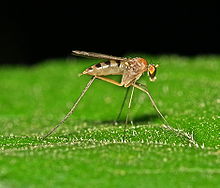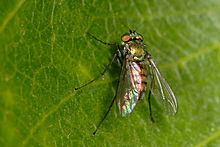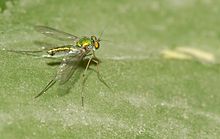- Dolichopodidae
-
Dolichopodidae
Temporal range: Cretaceous – Recent
Sciapus sp. Scientific classification Kingdom: Animalia Phylum: Arthropoda Class: Insecta Order: Diptera Suborder: Brachycera Infraorder: Asilomorpha Superfamily: Empidoidea Family: Dolichopodidae Subfamilies - Achalcinae
- Diaphorinae
- Dolichopodinae
- Hydrophorinae
- Medeterinae
- Microphorinae
- Neurigoninae
- Rhaphiinae
- Sciapodinae
- Sympycninae
Diversity About 230 genera, more than 7,000 species Synonyms Dolichopidae
Dolichopodidae, the long-legged flies, make up a large family of true flies with more than 7,000 described species in about 230 genera distributed worldwide. The genus Dolichopus is the most speciose, with some 600 species. They are generally small flies with large, prominent eyes and a metallic cast to their appearance, though considerable variation is observed. Most have long legs, though some do not. The males often have enlarged genitalia which can be useful for species recognition. The adults are predatory on other small animals.
This family includes the subfamily Microphorinae, formerly placed in Empididae, and briefly considered a separate family.[1]
Contents
Ecology and behaviour
Foraging and nuptial behaviour of Poecilobothrus nobilitatus (video, 2m 58s)
Dolichopodidae give visual (as distinct from chemical or other) signals during courtship; many studies have been undertaken of this behavior.[2] The larvae occupy a wide range of habitats, both terrestrial and aquatic, and can be predators or scavengers.
Evolution and systematics
Dolichopodids are well represented in amber deposits throughout the world and the group has clearly been well distributed since the Cretaceous at the latest. Together with the Empididae they are the most advanced members of the Empidoidea. They represent the bulk of Empidoidea diversity, containing more than two-thirds of the known species in their superfamily.
Internal relationships of the Dolichopodidae and their delimitation versus the Empididae are not yet resolved to satisfaction. It is likely that the considerable number of subfamilies is subject to change.[3]
See also
Footnotes
References
- Moulton, J.K. and Wiegmann, B.M. (2007): The phylogenetic relationships of flies in the superfamily Empidoidea (Insecta: Diptera). Mol. Phylogenet. Evol. 43(3): 701–713. doi:10.1016/j.ympev.2007.02.029 (HTML abstract)
- Irwin, Tony (2007): Neurigona courtship. Version of 2007-JUN-18. Retrieved 2008-JUL-30.
- Sinclair, B.J. and Cumming, J.M. (2006): The morphology, higher-level phylogeny and classification of the Empidoidea (Diptera). Zootaxa 1180: 1–172. PDF fulltext
- Vikhrev, Nikita (2007): Observations on Medetera jacula (Fallén, 1823). Version of 2007-JAN-22. Retrieved 2008-JUL-30.
- Zimmer, Martin; Diestelhorst, Olaf and Lunau, Klaus (2003): Courtship in long-legged flies (Diptera: Dolichopodidae): function and evolution of signals. Behavioral Ecology 14(4): 526–530. PDF fulltext
External links
- Bug Guide images
- Diptera.info images
- Igor Grichanov Dolichopodidae home page
- Family description
- Family description
- University of Lille Multi-imaged site. Whole specimens and parts.
- Palaearctic species list
- Nearctic species list
- Australasian and Oceanian species list
- Japan species list
- Video of sciapodine of Texas
Categories:- Dolichopodidae
- Insect families
Wikimedia Foundation. 2010.


